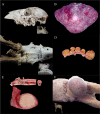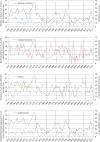Assessing Fifty Years of General Health Surveillance of Roe Deer in Switzerland: A Retrospective Analysis of Necropsy Reports
- PMID: 28103325
- PMCID: PMC5245894
- DOI: 10.1371/journal.pone.0170338
Assessing Fifty Years of General Health Surveillance of Roe Deer in Switzerland: A Retrospective Analysis of Necropsy Reports
Abstract
General wildlife health surveillance is a valuable source of information on the causes of mortality, disease susceptibility and pathology of the investigated hosts and it is considered to be an essential component of early warning systems. However, the representativeness of data from such surveillance programs is known to be limited by numerous biases. The roe deer (Capreolus capreolus capreolus) is the most abundant ungulate and a major game species all over Europe. Yet, internationally available literature on roe deer pathology is scarce. The aims of this study were (1) to provide an overview of the causes of mortality or morbidity observed in roe deer in Switzerland and to assess potential changes in the disease pattern over time; and (2) to evaluate the value and limitations of a long term dataset originating from general wildlife health surveillance. We compiled 1571 necropsy reports of free ranging roe deer examined at the Centre for Fish and Wildlife Health in Switzerland from 1958 to 2014. Descriptive data analysis was performed considering animal metadata, submitter, pathologist in charge, laboratory methods, morphological diagnoses and etiologies. Recurrent causes of mortality and disease pictures included pneumonia, diarrhea, meningoencephalitis, actinomycosis, blunt trauma, predation, neoplasms and anomalies. By contrast, other diagnoses such as fatal parasitic gastritis, suspected alimentary intoxication and reproductive disorders appeared only in earlier time periods. Diseases potentially relevant for other animals or humans such as caseous lymphadenitis (or pseudotuberculosis), salmonellosis, paratuberculosis and listeriosis were sporadically observed. The disease pattern in roe deer from Switzerland was largely in accordance with previous reports. The observed fluctuations were consistent with methodical and/or personnel changes and varying disease awareness. Nevertheless, despite such limitations, the compiled data provide a valuable baseline. To facilitate comparison among studies, we recommend systematically archiving all case documents and fixed tissues and to perform data analyses more regularly and in a harmonized way.
Conflict of interest statement
The authors have declared that no competing interests exist.
Figures







Similar articles
-
Twenty Years of Passive Disease Surveillance of Roe Deer (Capreolus capreolus) in Slovenia.Animals (Basel). 2021 Feb 5;11(2):407. doi: 10.3390/ani11020407. Animals (Basel). 2021. PMID: 33562662 Free PMC article.
-
Babesia capreoli infections in alpine chamois (Rupicapra r. Rupicapra), roe deer (Capreolus c. Capreolus) and red deer (Cervus elaphus) from Switzerland.J Wildl Dis. 2009 Jul;45(3):748-53. doi: 10.7589/0090-3558-45.3.748. J Wildl Dis. 2009. PMID: 19617485
-
Parasitic pneumonia in roe deer (Capreolus capreolus) in Cornwall, Great Britain, caused by Varestrongylus capreoli (Protostrongylidae).BMC Vet Res. 2018 Jun 22;14(1):198. doi: 10.1186/s12917-018-1525-x. BMC Vet Res. 2018. PMID: 29929509 Free PMC article.
-
Embryonic diapause in roe deer: A model to unravel embryo-maternal communication during pre-implantation development in wildlife and livestock species.Theriogenology. 2020 Dec;158:105-111. doi: 10.1016/j.theriogenology.2020.06.042. Epub 2020 Jul 6. Theriogenology. 2020. PMID: 32947063 Review.
-
[Ixodes ricinus, transmitted diseases and reservoirs].Parassitologia. 2004 Jun;46(1-2):119-22. Parassitologia. 2004. PMID: 15305699 Review. Italian.
Cited by
-
Spatiotemporal spread of sarcoptic mange in the red fox (Vulpes vulpes) in Switzerland over more than 60 years: lessons learnt from comparative analysis of multiple surveillance tools.Parasit Vectors. 2019 Nov 5;12(1):521. doi: 10.1186/s13071-019-3762-7. Parasit Vectors. 2019. PMID: 31690337 Free PMC article. Review.
-
Deer Rescue in Tuscany: Retrospective Analysis and Assessment of Radiography Diagnoses.Animals (Basel). 2021 Oct 29;11(11):3087. doi: 10.3390/ani11113087. Animals (Basel). 2021. PMID: 34827819 Free PMC article.
-
Case report: Renal malformations in wild roe deer (Capreolus capreolus) in Central Poland.Front Vet Sci. 2025 Feb 18;12:1523216. doi: 10.3389/fvets.2025.1523216. eCollection 2025. Front Vet Sci. 2025. PMID: 40041667 Free PMC article.
-
Seroprevalence of infectious pathogens of zoonotic and veterinary importance in wild ruminants from Slovenia.Front Vet Sci. 2024 Jun 10;11:1415304. doi: 10.3389/fvets.2024.1415304. eCollection 2024. Front Vet Sci. 2024. PMID: 38915887 Free PMC article.
-
Gastric Ulcers in Alpacas- Clinical, Laboratory, and Pathological Findings.Front Vet Sci. 2022 May 18;9:877257. doi: 10.3389/fvets.2022.877257. eCollection 2022. Front Vet Sci. 2022. PMID: 35664847 Free PMC article.
References
-
- Kuiken T, Ryser-Degiorgis MP, Gavier-Widén D, Gort0078zar C. Establishing a European network for wildlife health surveillance. Rev Sci Tech Int Off Epizoot. 2011;30: 755–761. - PubMed
-
- Leighton A. Surveillance of wild animal diseases in Europe. Rev Sci Tech Int Off Epizoot. 1995;14: 819–830. - PubMed
-
- Hewison AJM, Morellet N, Verheyden H, Daufresne T, Angibault J-M, Cargnelutti B, et al. Landscape fragmentation influences winter body mass of roe deer. Ecography. 2009;32: 1062–1070.
-
- Ferron ES, Verheyden H, Hummel J, Cargnelutti B, Lourtet B, Merlet J, et al. Digestive plasticity as a response to woodland fragmentation in roe deer. Ecol Res. 2012;27: 77–82.
MeSH terms
LinkOut - more resources
Full Text Sources
Other Literature Sources

